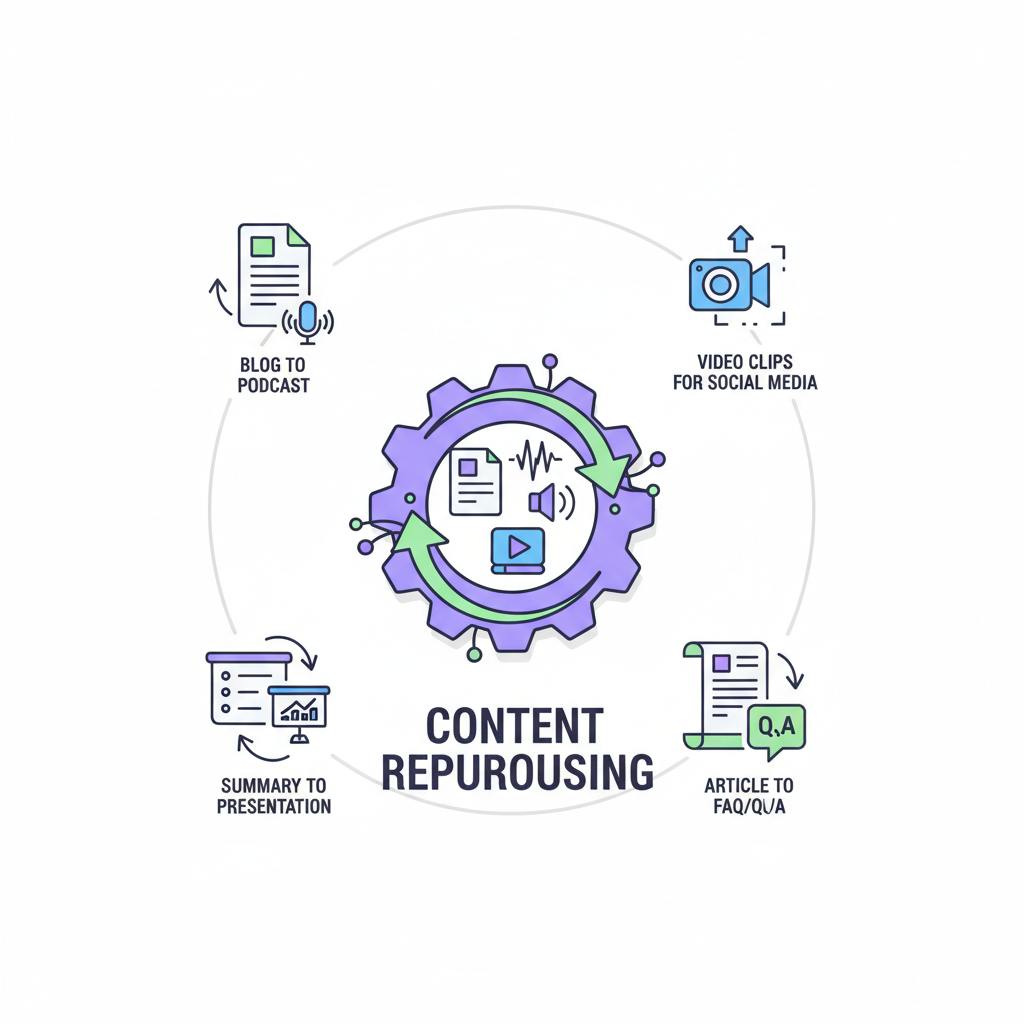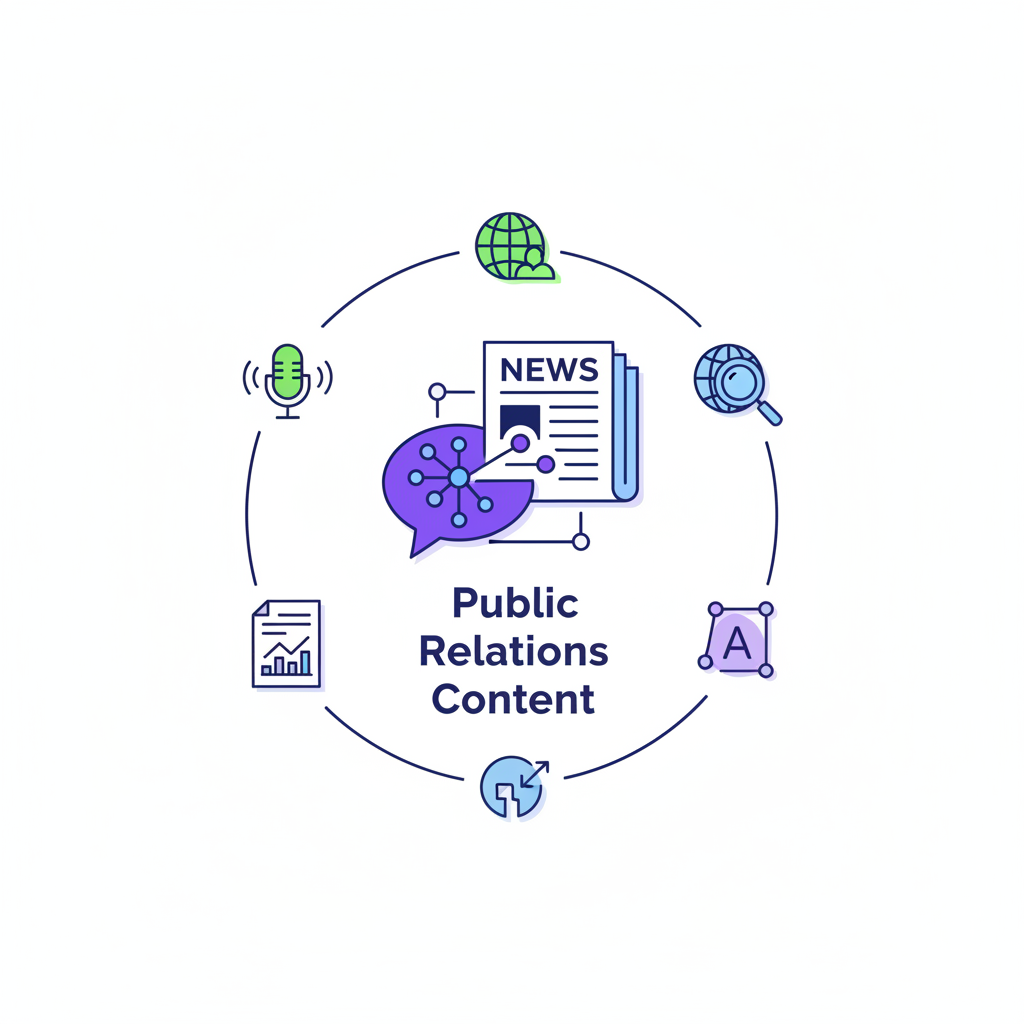Top 10 AI Tools for Content Repurposing
Content repurposing is revolutionized by AI. Discover the top 10 AI tools—like Descript for video clipping, Opus Clip for viral shorts, and Jasper for text transformation—that maximize your content's reach, save hours of manual work, and scale your content strategy exponentially.

In today's saturated digital landscape, creating high-quality content is only half the battle. According to industry estimates, over 100 billion messages are sent on WhatsApp and 600 million tweets are posted every single day. This relentless flood of information means that even the most brilliant blog post, insightful podcast, or engaging webinar can get lost in the noise moments after it's published. The challenge for creators and marketers is no longer just about production; it's about maximizing the reach, impact, and lifespan of every single piece of content they create. This is where content repurposing, supercharged by Artificial Intelligence, becomes an indispensable strategy.
Content repurposing is the practice of taking one core piece of content and transforming it into multiple different formats to be shared across various platforms. It’s about working smarter, not harder. Instead of constantly being on the content creation treadmill, you can strategically multiply the value of your existing assets. This article serves as your comprehensive guide to the AI tools that are revolutionizing this process. We will explore everything from the foundational concepts of content repurposing to a detailed breakdown of the top 10 AI tools that can automate and elevate your workflow, helping you save time, expand your audience, and achieve a greater return on your content investment.
What is Content Repurposing? A Foundational Definition
At its core, content repurposing is the art and science of strategically reusing existing content by changing its format or target audience. Think of it as content recycling, but with a purpose. Instead of creating a dozen new ideas from scratch, you take one well-researched, high-value "pillar" piece of content and slice, dice, and reformat it into numerous "micro" pieces. For example, a comprehensive webinar can be repurposed into a series of blog posts, a downloadable PDF guide, dozens of short video clips for social media, an audio-only podcast episode, an infographic summarizing key statistics, and a set of quote graphics for Instagram.
The core concept is simple: maximize the value of the effort you've already invested. By doing so, you reinforce your message through repetition across different channels, reaching new audience segments who might prefer different content formats. Someone who doesn't have an hour for your webinar might have five minutes for a blog post or 60 seconds for a TikTok video that covers the same key point.
While the idea isn't new—politicians have been turning speeches into pamphlets for centuries—the evolution of digital media and, more recently, artificial intelligence has transformed its potential. Manually transcribing a video, writing a summary, and designing social graphics used to take a team of people hours or even days. Today, AI can accomplish these tasks in minutes, making sophisticated content repurposing strategies accessible to everyone from solo creators to large enterprise marketing teams.
Why AI-Powered Content Repurposing is a Game-Changer: The Core Benefits
Integrating Artificial Intelligence into your content repurposing workflow isn't just an incremental improvement; it's a fundamental shift that unlocks new levels of efficiency and effectiveness. AI acts as a force multiplier, allowing you to achieve more with the same resources. Here are the core benefits that make AI-powered repurposing a true game-changer for content creators and marketers.
Massive Time and Cost Savings
This is the most immediate and tangible benefit. Consider the manual process of repurposing a one-hour podcast episode. It would require someone to listen and transcribe it (1-2 hours), identify key moments (30 minutes), write a summary blog post (1-2 hours), create social media captions (30 minutes), and design quote graphics (1 hour). This is a half-day's work for a skilled professional. An AI tool can transcribe the audio in minutes with over 95% accuracy, automatically identify key topics, generate a draft blog post, and even create video clips from the most compelling segments, all in under 30 minutes. This frees up your team to focus on high-level strategy and creativity rather than tedious, repetitive tasks.
Unprecedented Scale and Consistency
AI removes the human bottleneck in content production. A human can only repurpose so much content in a day, but an AI can work 24/7. This allows you to scale your output exponentially. You can run your entire back catalog of webinars or blog posts through an AI tool and generate a year's worth of social media content in a single afternoon. This scale also fosters brand consistency. AI can be trained to follow specific style guides, tones, and formatting rules, ensuring that every repurposed piece of content, regardless of format, aligns perfectly with your brand voice.
Enhanced Creativity and Format Exploration
Paradoxically, automation can lead to more creativity. By handling the heavy lifting, AI gives you the freedom to experiment with new formats you previously didn't have the time or resources to explore. Have you ever wanted to turn your blog posts into an audio series? AI text-to-speech tools can do that. Curious if your podcast interviews would work as animated videos? AI video generation tools can create a proof of concept in minutes. AI can analyze your content and suggest novel repurposing angles you may not have considered, acting as a creative partner in the process.
The Key Pillars of AI Content Repurposing: A Deep Dive into the Components
To truly understand the power of AI in this domain, it's essential to break down the core functionalities that these tools offer. These are the key pillars or capabilities that enable the transformation of one content format into another. Most top-tier tools will specialize in one or two of these areas, while more comprehensive platforms may combine several.
Pillar 1: Transcription and Summarization
This is the foundational layer for most audio and video repurposing. AI-powered transcription services use advanced speech-to-text algorithms to convert spoken words into a written document with remarkable accuracy. This is the critical first step to turning a podcast, webinar, or interview into a blog post, show notes, or social media captions.
- Key Elements: Speaker identification (diarization), timestamping, filler word removal (e.g., 'um', 'ah'), and custom vocabulary for industry-specific terms.
- The AI Advantage: What used to be a laborious manual task is now completed in minutes. Beyond simple transcription, AI can then analyze the text to generate concise summaries, identify key topics, pull out memorable quotes, and even suggest potential headlines for blog posts derived from the content.
Pillar 2: Text-to-Multimedia Conversion
This pillar involves transforming written content, like a blog post or a script, into engaging multimedia formats. It’s one of the most powerful ways to breathe new life into your existing text-based assets and reach audiences on visually-driven platforms like YouTube, Instagram, and TikTok.
- Key Elements: AI-powered video creation, text-to-speech for voiceovers, and automated image/graphic generation.
- The AI Advantage: AI tools can read your blog post, understand its structure and key points, and automatically find relevant stock footage, images, and background music to create a compelling video. Advanced tools can generate realistic AI voiceovers in multiple languages or even create custom images and infographics based on the text, turning a static article into a dynamic multimedia experience.
Pillar 3: Video and Audio Intelligence
This is where AI goes beyond simple conversion and begins to understand the content itself. These tools analyze long-form video or audio files to identify the most valuable, shareable moments automatically. This is particularly crucial for creating short-form content for social media.
- Key Elements: Virality scoring, topic detection, scene change analysis, and automated clipping.
- The AI Advantage: An AI can watch a one-hour video and, based on its analysis of speaker engagement, topical relevance, and visual cues, automatically identify the 10 most compelling 60-second segments. It can then reframe these clips into vertical formats (9:16), add animated captions, and provide a "virality score" to help you prioritize which clips to post, saving countless hours of manual video editing.
Pillar 4: Content Rewriting and Format Adaptation
This pillar focuses on intelligently rephrasing and restructuring content for different platforms and audiences. It’s not just about copying and pasting; it’s about adapting the tone, style, and length to fit the context of the new channel.
- Key Elements: Paraphrasing, tone adjustment, format shifting (e.g., blog post to Twitter thread), and translation.
- The AI Advantage: AI can take a formal paragraph from a whitepaper and rewrite it as a casual, engaging LinkedIn post. It can condense a 2,000-word article into a 10-tweet thread, complete with emojis and hashtags. It can also translate content into different languages, instantly globalizing your reach. This ensures that your message resonates effectively, no matter where it's published.
The Top 10 AI Tools for Content Repurposing
Now that we've covered the fundamentals, let's dive into the specific tools that can execute these strategies. Each tool has its unique strengths, so the best choice will depend on your primary content format and repurposing goals. Here is a comparative overview of our top picks.
| Tool | Primary Use Case | Best For | Key Repurposing Feature |
|---|---|---|---|
| Descript | All-in-one video/audio editing | Podcasters & Video Creators | Edit-by-text transcription and clipping |
| Opus Clip | Long video to viral shorts | Social Media Managers | AI-powered virality scoring & clipping |
| Pictory | Text and long video to short video | Marketers & Bloggers | Article-to-Video and Script-to-Video |
| Jasper | Text-to-text transformation | Marketing Teams | Content Summarizer & Rephraser templates |
| ChatGPT | Versatile content adaptation | All Content Creators | Format conversion and idea generation |
| QuillBot | Paraphrasing and summarizing | Writers & Academics | High-quality text rewriting & Co-Writer |
| Copy.ai | Marketing copy generation | Small Businesses | Pre-built repurposing workflows |
| Writesonic | SEO content and text repurposing | SEO Specialists | AI Article Writer & Paraphrasing Tool |
| Claude | Advanced text analysis & generation | Researchers & Strategists | Summarizing long documents and reports |
| Midjourney | Text-to-image generation | Designers & Social Media | Creating unique visuals from content |
1. Descript
Primary Use Case: All-in-one audio and video editing via text transcription.
Descript is a revolutionary tool that blurs the line between a document editor and a video editor. It transcribes your audio or video file, and then you can edit the media simply by editing the text. Deleting a word in the transcript removes it from the video. This makes it incredibly intuitive for content creators to edit and repurpose their work.
- Key Features: Edit by Text, Studio Sound (noise removal/enhancement), Overdub (AI voice cloning), AI-powered clip finder.
- How it Works in Practice: You upload a webinar recording. Descript transcribes it. You read through the text, deleting filler words and irrelevant sections. Then, you highlight a powerful quote, right-click, and select "Create Clip." Descript instantly generates a short video of that segment, which you can then add captions to and export for social media.
2. Opus Clip
Primary Use Case: Turning long-form videos into viral short-form clips.
Opus Clip is designed for one purpose and it does it exceptionally well: it takes a long video (like a YouTube video, webinar, or podcast) and uses AI to find the most engaging, shareable moments, then automatically edits them into viral-style short clips for TikTok, Reels, and YouTube Shorts.
- Key Features: AI Curation (identifies hooks/highlights with a virality score), AI Dynamic Layout (reframes horizontal video to vertical), Animated Captions, Brand Templates.
- How it Works in Practice: You paste a link to your latest YouTube interview. Opus Clip analyzes the entire video and returns 10-15 short clips, each with a title, a summary of why it was chosen, and a virality score. You review the clips, make minor tweaks, and download them, ready to be posted.
3. Pictory
Primary Use Case: Creating videos from text-based content like blog posts and scripts.
Pictory excels at turning any text into a professional-looking video. It's perfect for bloggers who want to create video versions of their articles or marketers who want to visualize scripts and reports. It leverages a massive library of stock media to automate the video creation process.
- Key Features: Article-to-Video (creates storyboard from URL), Script-to-Video, AI Voiceovers, Auto-Summarization.
- How it Works in Practice: You have a top-performing blog post. You paste its URL into Pictory. The AI pulls out key sentences for each scene, finds relevant stock video clips, and lays them out on a timeline. You can then select an AI voice to read the text, add your branding, and export a new video asset for YouTube.
4. Jasper
Primary Use Case: High-quality text-to-text transformation and marketing copy generation.
Jasper is one of the most powerful and versatile AI writing assistants available. While it can create content from scratch, its true strength in repurposing lies in its ability to take existing text and transform it. With over 50 templates, you can summarize, rephrase, and adapt content for any marketing channel.
- Key Features: Content Summarizer, Tone of Voice Adjustment, Content Improver, Pre-built templates for social media, ads, and emails.
- How it Works in Practice: You take the transcript from your podcast interview. You paste a 500-word segment into Jasper and use the "Tweet Storm" template to instantly generate a 10-part Twitter thread. Then, you use the "LinkedIn Post" template to create a more professional version for that platform.
5. ChatGPT
Primary Use Case: Versatile and flexible content adaptation and brainstorming.
As a powerful large language model from OpenAI, ChatGPT is a jack-of-all-trades for content repurposing. It doesn't have a specialized interface like the other tools, but its conversational nature allows for highly specific and creative repurposing requests. Its power lies in its flexibility.
- Key Features: Format Conversion, Idea Generation, Custom Instructions (train it on your brand's tone), Data Analysis.
- How it Works in Practice: You paste the full text of a case study into ChatGPT and prompt it: "Act as a social media manager. Create three Instagram captions, one LinkedIn post, and a 30-second video script based on this case study. The tone should be inspiring and professional."
6. QuillBot
Primary Use Case: Advanced paraphrasing, summarizing, and text rewriting.
QuillBot is a specialist tool focused on refining and rewriting text. It's more than just a synonym swapper; its AI understands context to produce natural-sounding variations of your original content. This is perfect for avoiding duplicate content issues and tailoring your message for different audiences without starting from scratch.
- Key Features: Paraphraser (with multiple modes like Fluency, Formal, Creative), Summarizer, Co-Writer, Grammar Checker.
- How it Works in Practice: You have a section from a blog post that you want to use in an email newsletter. You paste it into QuillBot's Paraphraser and select the "Creative" mode to get a fresh, engaging version that feels new to your audience.
7. Copy.ai
Primary Use Case: Generating marketing copy and repurposing content with pre-built workflows.
Copy.ai is designed to streamline the content marketing process. It offers a suite of tools and workflows specifically for repurposing. It's particularly strong at taking a single piece of information and exploding it into various types of marketing copy.
- Key Features: Workflow-based approach, Brand Voice, Chat Interface, Extensive template library for ads, social media, and sales copy.
- How it Works in Practice: You input your latest blog post URL into a Copy.ai workflow. The tool automatically generates a set of LinkedIn posts, Facebook ad copy, and email subject lines, all tailored to the content of the blog post and written in your pre-defined brand voice.
8. Writesonic
Primary Use Case: Creating and repurposing SEO-optimized content.
Writesonic combines a powerful AI writer with SEO tools, making it ideal for repurposing content with search engine visibility in mind. It can help you rewrite existing blog posts to target new keywords or summarize content in an SEO-friendly way.
- Key Features: AI Article Writer, Paraphrasing Tool, Sonic Editor (integrated AI writing and optimization), Surfer SEO Integration.
- How it Works in Practice: You have an old blog post that gets some traffic. You use Writesonic to paraphrase and update it, then use the Surfer integration to optimize it for a new, higher-volume keyword, effectively creating a new SEO asset from an old one.
9. Claude
Primary Use Case: Analyzing and summarizing very long documents and complex text.
Claude, from Anthropic, is known for its large context window, meaning it can process and understand much larger amounts of text in a single prompt than many other models. This makes it exceptionally good for repurposing dense, long-form content like e-books, research papers, or multi-hour transcripts.
- Key Features: Large Context Window (analyzes hundreds of pages), Superior Summarization, Nuanced Tone and Style, Strong Reasoning Abilities (extracts complex arguments).
- How it Works in Practice: You upload a 100-page PDF of a market research report. You ask Claude to provide a 10-point executive summary, identify the three most surprising findings, and write a blog post introduction based on the report's main conclusion.
10. Midjourney
Primary Use Case: Creating unique, high-quality images from text descriptions.
While not a traditional content repurposing tool, Midjourney is a powerful asset for visual repurposing. It allows you to create completely original images, illustrations, and graphics to accompany your repurposed text content. This helps your content stand out and avoids the use of generic stock photos.
- Key Features: High-Quality Image Generation, Style Consistency, Aspect Ratio Control, Image-to-Image Generation.
- How it Works in Practice: You've repurposed a blog post about "The Future of Urban Gardening." You use Midjourney with the prompt, "A photorealistic image of a futuristic rooftop garden in a bustling city at sunset, with lush greenery and glowing hydroponic tubes, cinematic lighting." You now have a unique, eye-catching hero image for your article and social posts.
Common Pitfalls in AI Content Repurposing and How to Avoid Them
While AI tools offer incredible potential, they are not a magic bullet. Relying on them blindly can lead to subpar content that fails to connect with your audience. Here are some common pitfalls and how to steer clear of them.
1. Overlooking the Human Touch
The biggest mistake is removing humans from the loop entirely. AI-generated content can sometimes lack nuance, emotional depth, or strategic context. It's a powerful assistant, not a replacement for a content strategist.
How to Avoid It: Always treat AI output as a first draft. Have a human editor review, refine, and add personal anecdotes, brand-specific insights, and a final layer of polish. The goal is AI-assisted, not AI-generated.
2. Ignoring Platform Context
Simply re-posting the same content everywhere is not effective repurposing. A formal paragraph from a whitepaper will fall flat on TikTok, and a meme-filled video clip will seem out of place on LinkedIn. AI can change the format, but it doesn't always understand the culture of the platform.
How to Avoid It: Use AI to do the heavy lifting of transformation, but then manually tweak the output for each platform. Adjust the caption, hashtags, and tone to match the expectations of the audience on that specific channel.
3. Sacrificing Quality for Quantity
The ease of AI can tempt you to churn out hundreds of content pieces. However, if the quality is poor—robotic voiceovers, inaccurate transcriptions, or nonsensical summaries—you will damage your brand's reputation more than you help it.
How to Avoid It: Focus on your best-performing pillar content first. Set up a quality assurance process for all AI-repurposed content. It's better to publish five high-quality repurposed assets than 50 low-quality ones.
The Future of Content Repurposing: Emerging AI Trends to Watch
The field of generative AI is evolving at a breathtaking pace, and its impact on content repurposing will only grow. Here are a few emerging trends that will shape the future of this strategy.
1. Multimodal AI Models
Currently, you often need one tool for text, another for video, and a third for images. Future AI models, like Google's Gemini or OpenAI's GPT-4o, are inherently multimodal. This means a single AI will be able to watch a video, understand its content, write a blog post about it, generate a custom thumbnail image, and compose a theme song for it—all within one seamless interface. This will consolidate tool stacks and make the repurposing workflow even more efficient.
2. Hyper-Personalization at Scale
AI will enable content to be repurposed not just for different platforms, but for different individuals. An AI could take a single webinar and create a summary video tailored to a CEO's strategic interests, a technical deep-dive for an engineer, and a sales-focused version for a marketing manager, all automatically. This allows for a level of personalization in content delivery that is currently impossible.
3. Autonomous Content Agents
Looking further ahead, we may see AI agents that can autonomously manage the entire repurposing lifecycle. You would connect the agent to your content library (YouTube channel, blog, etc.), and it would continuously monitor for new content, analyze its performance, and automatically repurpose and distribute it across all your channels based on what is performing best, constantly learning and optimizing the strategy with minimal human intervention.
Conclusion: Key Takeaways and Your Next Steps
Content repurposing is no longer a 'nice-to-have' tactic; it's a core component of a modern, efficient content strategy. By leveraging the power of AI, you can transform this process from a time-consuming chore into a scalable system for growth. The right AI tool can help you save hundreds of hours, reach a wider audience, and ensure every piece of content you create delivers maximum return on investment. The future of content creation is smart, scaled, and highly efficient—and the tools on this list are your gateway to that future. Embrace your new AI co-pilot and start multiplying your content today.
Featured Tools

10Web is an AI-powered WordPress platform that offers automated website building, hosting, and optimization with AI assistance for content and image generation.

A global creative platform connecting businesses with freelance designers for custom graphic design projects.

Acquire.io is a customer engagement platform offering live chat, AI chatbots, co-browsing, and video chat to enhance customer support and sales.

A customer experience automation platform combining email marketing, marketing automation, and CRM with AI-powered personalization.

An AI-powered customer service automation platform that delivers personalized, instant support across various channels.
Top AI Categories
Related Articles

Top 10 AI Tools for Fashion Bloggers
Discover insights about AI tools and technology.

Top 10 AI Tools for Public Relations Content
Discover insights about AI tools and technology.

Top 10 AI Tools for Sales Enablement
Discover insights about AI tools and technology.